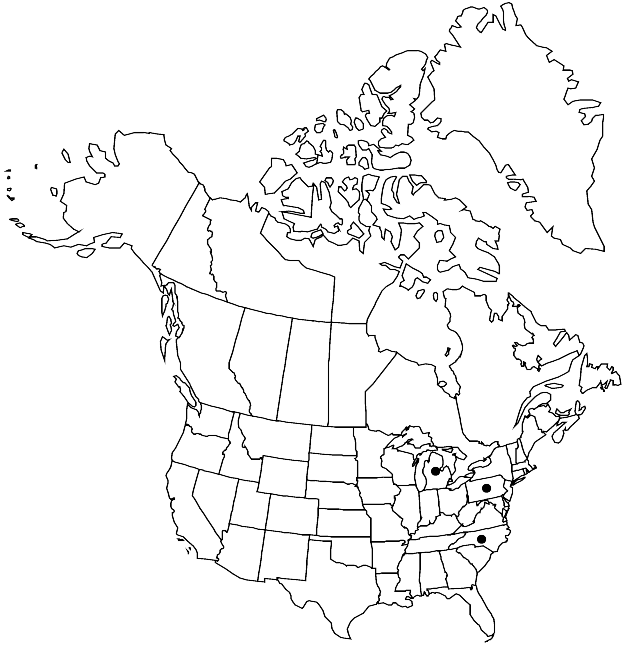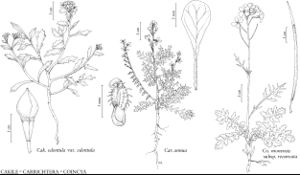Difference between revisions of "Coincya monensis subsp. recurvata"
Bot. J. Linn. Soc. 102: 370. 1990.
FNA>Volume Importer |
imported>Volume Importer |
||
| (2 intermediate revisions by 2 users not shown) | |||
| Line 41: | Line 41: | ||
|habitat=Fields, roadsides, mountain road cuts, cliff ledges | |habitat=Fields, roadsides, mountain road cuts, cliff ledges | ||
|distribution=Mich.;N.C.;Pa.;w Europe;nw Africa. | |distribution=Mich.;N.C.;Pa.;w Europe;nw Africa. | ||
| + | |introduced=true | ||
|discussion=<p>Subspecies recurvata was first recorded from North America in 1880 on ballast in New Jersey (R. C. Rollins 1961, 1981, 1993; I. A. Al-Shehbaz 1985); it was first reported from North Carolina (as <i>Brassica</i> erucastrum) in 1958 from Yancey County and in 1968 from Jackson County (H. E. Ahles and A. E. Radford 1964; Al-Shehbaz). From Pennsylvania, <i></i>subsp.<i> recurvata</i> was reported from Luzerne County in 1964 and from Bradford County in 1983.</p> | |discussion=<p>Subspecies recurvata was first recorded from North America in 1880 on ballast in New Jersey (R. C. Rollins 1961, 1981, 1993; I. A. Al-Shehbaz 1985); it was first reported from North Carolina (as <i>Brassica</i> erucastrum) in 1958 from Yancey County and in 1968 from Jackson County (H. E. Ahles and A. E. Radford 1964; Al-Shehbaz). From Pennsylvania, <i></i>subsp.<i> recurvata</i> was reported from Luzerne County in 1964 and from Bradford County in 1983.</p> | ||
|tables= | |tables= | ||
| Line 64: | Line 65: | ||
|publication year=1990 | |publication year=1990 | ||
|special status= | |special status= | ||
| − | |source xml=https:// | + | |source xml=https://bitbucket.org/aafc-mbb/fna-data-curation/src/2e0870ddd59836b60bcf96646a41e87ea5a5943a/coarse_grained_fna_xml/V7/V7_645.xml |
|tribe=Brassicaceae tribe Brassiceae | |tribe=Brassicaceae tribe Brassiceae | ||
|genus=Coincya | |genus=Coincya | ||
Latest revision as of 22:35, 5 November 2020
Stems (0.8–)1–10 dm, usually sparsely to densely hispid basally, rarely glabrous, trichomes 0.5–3.6 mm. Basal leaves long-petiolate; blade (3–)5–20 cm × 25–100 mm, lobes 3–9(–10) each side, surfaces sparsely to densely hispid, rarely coriaceous or glaucous, trichomes patent, rarely appressed. Cauline leaves: blade similar to basal, (lobes fewer, narrower than basal). Racemes 2–8(–15)-flowered, open at one time. Flowers: sepals: median pair apex cucullate, (setulose below apex), lateral pair broader, saccate basally; petals 12.5–22(–26) × 2.5–7(–9) mm, claw nearly as long as sepal. Fruits usually straight, rarely curved, (1–)3–9 cm; proximal segment (15–)20–75(–90)-seeded, (8–)25–75 × 1.5–3 mm, apex obtuse; terminal segment (0 or)1–5-seeded, (5–)7–23(–34) × 1.5–3 mm; style relatively short. Seeds black to brown, subglobose, 0.8–1.6 × 0.8–1.4 mm. 2n = 24, 48.
Phenology: Flowering May–Aug.
Habitat: Fields, roadsides, mountain road cuts, cliff ledges
Distribution

Introduced; Mich., N.C., Pa., w Europe, nw Africa.
Discussion
Subspecies recurvata was first recorded from North America in 1880 on ballast in New Jersey (R. C. Rollins 1961, 1981, 1993; I. A. Al-Shehbaz 1985); it was first reported from North Carolina (as Brassica erucastrum) in 1958 from Yancey County and in 1968 from Jackson County (H. E. Ahles and A. E. Radford 1964; Al-Shehbaz). From Pennsylvania, subsp. recurvata was reported from Luzerne County in 1964 and from Bradford County in 1983.
Selected References
None.
